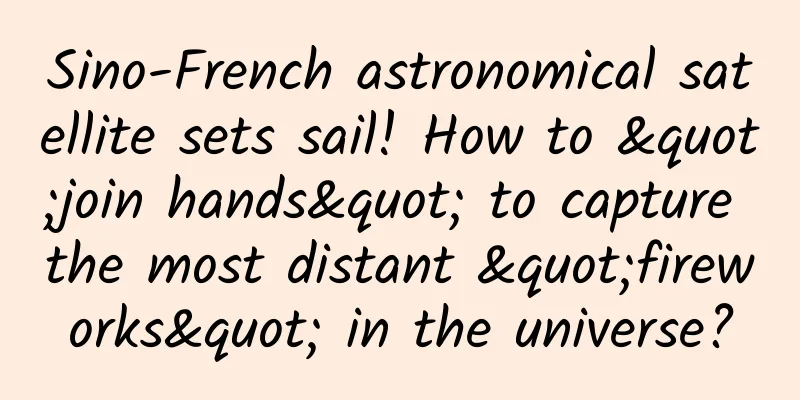Sino-French astronomical satellite sets sail! How to "join hands" to capture the most distant "fireworks" in the universe?

|
At 15:00 on the 22nd, at the Xichang Satellite Launch Center, the Sino-French Astronomical Satellite (SVOM) was lifted off by the Long March 2C carrier rocket and then entered the planned orbit. The launch mission was a complete success. This satellite, which embodies the efforts of Chinese and French scientists for nearly 20 years, will help humans capture the brilliant but fleeting gamma-ray bursts produced by fireworks in the "infancy" of the universe. Astronomers call these "fireworks" transient sources. The most violent explosion since the Big Bang Bertrand Cordier, the French chief scientist of the Sino-French astronomical satellite, witnessed the successful launch of the satellite in the valley of the Xichang Satellite Launch Center. Although Cordier has participated in many space science projects, this is his first time watching a rocket take off. He has been very nervous in the past few days and now he is finally relieved, but he still faces a series of arduous scientific research tasks. "It's very interesting that China may have been the first civilization to observe transient sky changes 4,000 years ago. They kept ancient records of comets, supernovae, etc. Our mission continues the work started by the Chinese 4,000 years ago," said Cordier. "We hope to see the earliest gamma-ray bursts from the most distant universe and study the 'infancy' and evolution of the universe. We also hope to discover special and rare gamma-ray bursts, or even new types of gamma-ray bursts. For example, gamma-ray bursts accompanied by kilonovae have only been discovered twice so far, and they are an international research hotspot. Our satellite is very suitable for finding them, and will be of great significance to the study of stellar evolution and answering very interesting scientific questions such as 'where do elements such as gold, silver and rare earths come from?'" said Wei Jianyan, the satellite's chief Chinese scientist. The effect of the Sino-French astronomical satellite. Image courtesy of the French Space Agency Gamma-ray bursts are the most violent explosions in the known universe except for the Big Bang. They are produced by the collapse of massive stars or the merger of two compact stars. They last very short periods of time and are regarded by scientists as extreme physics laboratories in the universe. In-depth observation and research on gamma-ray bursts will help humans understand several major issues in basic science. "Using gamma-ray bursts, we can observe the early universe and the earliest stars. We will open a new window for detecting gamma-ray bursts, hoping to discover new phenomena and new celestial bodies that humans still know nothing about," said Cordier. The satellite is equipped with four instruments, which are divided into two categories: large field of view and high-precision observation. The observation field of the large field of view detection instrument is about 10,000 square degrees, which is equivalent to covering a quarter of the entire sky. It is like spreading a large net to capture the unpredictable and fleeting gamma-ray bursts in the sky. Once a target is found, the satellite will automatically turn to the target and use two small field of view telescopes to carry out long-term high-precision observations. This project has a satellite-to-ground communication network with real-time downlink capability, which can realize the space-ground joint rapid response observation capability. After discovering the target, the satellite immediately sends the preliminary position and time information to the ground through the satellite-to-ground link within one minute, notifying the various band telescopes on the earth to point to the target. If scientists on the ground discover interesting targets in space, they can also use China's Beidou satellite system to command the satellite to point to the target within about 5 minutes. "Previous gamma-ray burst satellites in the world took at most 20 minutes to respond. This is a big leap forward," said Wei Jianyan. Collaboration brings scientific rewards to both China and France The Sino-French astronomical satellite adopts a cooperative mode in which China takes the lead, and both sides jointly carry out the overall satellite design, joint development, joint operation, joint analysis of scientific exploration data and publish scientific research results. From the start of the demonstration in 2005 to the launch of the satellite in 2024, the satellite project has gone through a long period of 20 years. After several twists and turns, it was completed with the unremitting joint efforts of both sides. "Unlike the cooperation form of carrying scientific instruments, the cooperation between the two countries began at the beginning of the conceptual design of the satellite. This satellite is the result of joint consultation and research between China and France." Wei Jianyan said that at the beginning, scientists and engineers from the two countries had their own ideas, but through sincere communication between the two sides, they finally reached a unified goal. This international cooperation has a long development cycle and requires a long time for communication. It has also been affected by uncertain factors such as the international situation and the epidemic. "Although we have experienced ups and downs for nearly 20 years, our original intention has not changed," he said. More than 100 researchers from both China and France have been involved in satellite research and development for a long time. Wei Jianyan said that the two sides learn from each other and each has its own strengths. Driven by the project, the researchers have enhanced their understanding of the cultures and national conditions of the two countries and have become firm supporters of China-France friendship and cooperation. "The cooperation has brought scientific returns to both countries, promoted breakthroughs in space technology, and enhanced the confidence of other countries in carrying out space science cooperation with China," he said. On the eve of the launch of the Sino-French astronomical satellite, scientists and engineers from the two countries posed in the shape of the satellite's English name, SVOM. Photo courtesy of the National Space Administration Zhang Yonghe, the Chinese project manager who participated in the development of the satellite throughout the process, said: "Among all the international cooperation projects I have participated in, this one is the most in-depth and complex. It lasts a long time, involves many people, and the cooperation is in-depth." Initially, scientists from the two countries communicated via email, then video conferencing, and now they basically use WeChat. "Gamma-ray bursts disappear quickly after they appear, and we have to respond quickly, so using WeChat is the most convenient and effective way to communicate," Cordier said. Working together to make greater contributions to global space science China and France have a long history of cooperation in the field of aerospace. Since the two governments signed a cooperation agreement in 1997, China and France have cooperated in many fields such as manned space flight, deep space exploration, and earth observation. In October 2018, the first satellite jointly developed by China and France, the Sino-French Ocean Satellite, was successfully launched. In April 2023, during French President Emmanuel Macron's visit to China, China presented France with 1.5 grams of scientific lunar samples. In May this year, Chang'e-6 was launched with a French radon gas detector. This was the first lunar exploration cooperation between China and France, and also the first French space project to land on the moon. At 15:00 on June 22, the Sino-French Astronomical Satellite (SVOM) was launched into space by the Long March 2C carrier rocket at the Xichang Satellite Launch Center. Xinhua News Agency (Photo by Chen Haojie) "China's space science has developed rapidly in the past 20 years. It is very important to cooperate with China. Cooperation will enable us to complete bigger projects and do better," said Cordier. Liu Yunfeng, deputy director of the International Cooperation Department of the National Space Administration, said that the successful launch of the Sino-French astronomical satellite on the 60th anniversary of the establishment of diplomatic relations between China and France is a contribution made by China and France to global space science. This is a landmark cooperation project between the two governments, with new technology and great challenges. The two sides have long-term cooperation in the field of aerospace, mutual trust, mutual assistance, and continued friendship. All-round cooperation brings win-win results. Producer: Lei Ming, Quan Xiaoshu, Wei Tiemin, Liu Chang Reporter: Yu Fei and Li Na Editor: Yang Xiaojing Xinhua News Agency External Produced by China Story Workshop |
Recommend
Now that both black boxes have been found, can we recover the truth? Why isn't the data transmitted back to the ground in real time?
Experts in this article: Liu Yuxuan, Tianjin Fore...
How much does it cost to develop a Jixi Rubber and Plastic Mini Program?
What is the investment cost of Jixi Rubber and Pl...
Jintan SEO Training: Revealing the three reasons why keyword rankings cannot be improved
It is not uncommon to hear SEO practitioners refl...
Watch Korean drama v1.0.8.5 to remove ads members cracked version, cracked software
Software Information Title: Watch Korean Dramas P...
LeEco receives 16.8 billion yuan in strategic investment to revive its business and is expected to surpass BAT and lead the Internet industry
"There will always be a time to ride the win...
Demonstration of classic SEO money-making project cases: How to make money through SEO?
One trick can make you successful. If you have so...
Android 6.0 devices are required to enable full disk encryption
The last thing everyone wants to see has happened...
The server is always busy? DeepSeek-R1 local deployment graphic tutorial is here
Recently, the domestic large-scale model DeepSeek...
Data analysis of information flow audience portrait. If you can understand it, I lose!
I have been doing advertising optimization for a ...
Nutritional comparison of 22 kinds of nuts, you will never guess the first one!
During festivals, nuts are the most popular snack...
Where is carbon dioxide placed? This time there are many new destinations!
Review expert: Gan Qiang, lecturer at Beijing Ins...
iOS large file breakpoint download
Source code introduction: Currently encapsulated*...
The US government handed over the management of Internet domain names, and the era of global co-governance has arrived
Under years of pressure from the international co...
2 million daily active users, 20% click-through rate, how to place subway Wi-Fi ads!
"Peanut Wi-Fi, Limei Wi-Fi, KFC - early enco...
Four signs that Apple is declining
[[144032]] Apple's stock price fell 2% this m...









